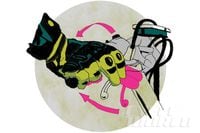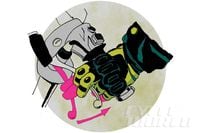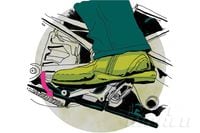Let’s begin our downshifting discussion with this premise: The corner entry serves to get the bike ready to exit. For roadracers, exits last longer than entries, so perfecting the entry means maximizing speed onto the next straight. For street riders, rushing the entry of a corner and crossing the centerline or leaving the right edge of the road is disastrous in just about every way.
Because the entry is so crucial to a bike’s change of direction and its exit, let’s spotlight everything that happens at the entry, including downshifts. Before delving into that, however, it’s important to stress that keeping the bike calm and controlled while approaching a corner lets the rider focus more clearly on entry speed, grip and the environment.
The best way to improve and smoothen your corner entry is by matching engine rpm to rear-wheel speed with a short rev, or blip, of the throttle before the clutch is re-engaged in the lower gear. We are all capable of this, and the reasons for mastering it are numerous. Your passenger, for instance, won’t bounce off your back with every bad downshift. Your clutch will also last longer, saving you money and hassle. What’s more, your slipper clutch will not just last longer, its feel will stay consistent throughout the clutch’s life. Also, as you gain confidence in blip downshifting, you’ll find yourself more often in the correct gear for good exits, and embarrassing yourself less at trackdays by not skidding the rear with every downshift. Lastly, you will be able to downshift at lean angle.
The downshift process, in steps: 1) Shut the throttle. 2) Apply the brakes (and keep them on during the entire downshift process). 3) Pull in the clutch. 4) Select a lower gear with your foot. 5) Blip the throttle (open then closed) with a short but measured twist of the throttle. 6) Let the clutch lever out. 7) Keep braking until you’re happy with your entry speed. Properly timing these steps is the main challenge most riders face.
Let’s fine-tune the procedure: Pull the brake lever with the tips of your fingers, leaving your fingers arched. Allow this arch to flex during the blip, so brake pressure isn’t added or released when the throttle is revved. Use two fingers on the clutch lever if you have the strength, and learn that the lever doesn’t need to come all the way to the bar to release the plates. Find the clutch’s friction point; it’s often reached with a very small amount of lever travel. Note: It’s not how many fingers you use on the clutch lever; it’s the manner in which you disengage and engage the clutch plates that matters. Learn to play with this friction point to fine-tune your smoothness, thinking of your left hand as a slipper clutch.



/cloudfront-us-east-1.images.arcpublishing.com/octane/JQYYZOU2VBDNPO2QQS672REQHE.jpg)
/cloudfront-us-east-1.images.arcpublishing.com/octane/XKJT4SI6HZAOTO4SBDVU66L2MQ.jpg)

/cloudfront-us-east-1.images.arcpublishing.com/octane/4UVTXD2DPVDEXCSLBMDAPEFWNQ.jpg)
/cloudfront-us-east-1.images.arcpublishing.com/octane/NREVLYTAKNB3NIIQRJGCGYBXHU.jpg)
/cloudfront-us-east-1.images.arcpublishing.com/octane/GVKW4WSC4NA6XEL3JPDGSTRRSA.jpg)
/cloudfront-us-east-1.images.arcpublishing.com/octane/ZCHPADKJI5EZPCFRD6HUMI6RAA.jpg)
/cloudfront-us-east-1.images.arcpublishing.com/octane/OTYNIYDLG5BMRIVZW2TFBAW5R4.jpg)
/cloudfront-us-east-1.images.arcpublishing.com/octane/NENHT3MW2JFV5M3JPHXOHVTLXQ.jpg)
/cloudfront-us-east-1.images.arcpublishing.com/octane/KO7HERZNSRG2FOIAQCLCNXYQYA.jpg)
/cloudfront-us-east-1.images.arcpublishing.com/octane/GASJTXMDUBCGDDJAUVS22I7BEA.jpg)
/cloudfront-us-east-1.images.arcpublishing.com/octane/BDU4JR5GBVE4JOG6TMYAKKM5WQ.jpg)
/cloudfront-us-east-1.images.arcpublishing.com/octane/HLIXJRNJ7FFXJDBH5QLH2BF3PI.jpg)
/cloudfront-us-east-1.images.arcpublishing.com/octane/2PTECARZVRFGLLBHS7T2XCID6E.jpg)
/cloudfront-us-east-1.images.arcpublishing.com/octane/ICN3LDEN4ZDILFAELNU6QMKVZU.jpg)
/cloudfront-us-east-1.images.arcpublishing.com/octane/3NUZ23QA3RD4POFPRQABCGPNJM.jpg)
/cloudfront-us-east-1.images.arcpublishing.com/octane/GIPX3W7WDJCZZMTFRUWHSRLI7Y.jpg)
/cloudfront-us-east-1.images.arcpublishing.com/octane/6NQ3I7Y3FBFBNOCCIIJ4EUXVQ4.jpg)
/cloudfront-us-east-1.images.arcpublishing.com/octane/X4L6LRIH2ZCJJFRI4K72WYJIJY.jpg)
/cloudfront-us-east-1.images.arcpublishing.com/octane/QQSS2G2RHVBX3A2QWC53HJYIPA.jpg)
/cloudfront-us-east-1.images.arcpublishing.com/octane/FXW7IC6UFBHYJOG2MBCZNDPB4Y.jpg)
/cloudfront-us-east-1.images.arcpublishing.com/octane/UOB32ESJURFZHDHUP4VRIYZE7A.jpg)
/cloudfront-us-east-1.images.arcpublishing.com/octane/3LT32IGOKJH55NLWI4IKMOH4FY.jpg)
/cloudfront-us-east-1.images.arcpublishing.com/octane/MQZO3BSX7VGFBEHZCZMTURYFJI.jpg)